Did a January Hurricane Just Set off a Massive Greenland Melt Event in Winter?
18
January, 2015
This
freakish Winter there’s
something odd and ominous afoot.
We’ve
seen unprecedented above-freezing temperatures at the North Pole
coincident with record low daily sea ice extents. We’ve seen global
temperatures hitting new, very extreme record highs. We’ve seen
climate change related storms raging across the globe — flooding
both the UK and the Central US, firing off record hurricanes during
January in both the Pacific and the Atlantic — even as other
regions swelter under record heat and drought.
(The
remnants of hurricane Alex being pulled into a storm system just
south of Greenland on Friday January 15, 2016. An event that then
flooded both Baffin Bay and Western Greenland with warm, tropical
air. At the same time, Greenland observers both noted what appears to
be ice mass losses over Western Greenland as well as a possible large
melt water outflow issuing from the Disko Bay area. Image
source: Earth
Nullschool.)
Greenland
Melt During Winter
Greenland
— the last bastion of major continental glacial ice in the Northern
Hemisphere. An island archipelago dwarfed by great mountains of
frozen water towering as high as two miles. Though the Arctic sea ice
provides quite extensive coverage — in the range of millions of
square miles — the great Greenland Ice Sheet contains the majority
of the remaining frozen fresh water in the Northern Hemisphere. And
though the extreme ongoing sea ice melt does not contribute to sea
level rise, Greenland melt is another matter entirely. In total, if
all of the Greenland Ice Sheet flooded into the world ocean, it would
raise global sea levels by an average of 23 feet. Enough to inundate
pretty much every coastal city in the world.
And
Greenland is melting, pushing those sea levels higher. Contributing
hundreds of cubic kilometers of melt water into the world ocean
system every year since at least the middle of the first decade of
the 21st Century. Creating an ominous ocean heat-conveyer that
spreads fresh, cool water out at the surface even as it pulls deep,
warmer water directly in toward the many glaciers whose towering
faces plunge into the ocean itself.
During
recent years, most of Greenland’s melt has occurred during the hot
season of summer even as the ice sheet underwent re-freeze and a
pseudo-recovery during Winter. Sure, net mass loss was in the range
of hundreds of billions of tons each year. But we still had
consistent and uninterrupted mass gain during Winter.
Unfortunately,
with human-forced warming there was always a danger that, during
Wintertime, we’d see an increase in melt pressure as well. At issue
is the way in which greenhouse gasses fundamentally warm the
atmosphere and oceans. Possessing the ability to re-radiate solar
energy, greenhouse gasses have a greater impact on temperatures
during times of darkness and during Winter. In other words, we’d
expect nighttime temperatures to warm faster than daytime
temperatures and we’d expect wintertime temperatures to warm faster
than summertime temperatures. Perhaps more ominously, the oceans are
very efficient holders of heat and are less impacted by seasonal
variance than the lands. In other words, if the world’s oceans
warm, they re-radiate much more heat back to the atmosphere and ice
sheet during Winter than they do during Summer.
This
kind of greenhouse gas warming is an assault on the winter season
itself. It’s something we’ve seen in the frequent extreme polar
warming episodes during recent years. One that this year generated a
very odd and ominous period of above-freezing temperatures at the
North Pole. But if there’s something even more odd than
temperatures at the North Pole hitting above freezing during Winter,
it’s an incident of substantial melt occurring over the Greenland
ice sheets during what should be the coldest, darkest season.
January
Hurricane Blows a Tropical Wind into the Arctic
Over
the past few days, just such a major heat-up has been underway across
a large section of Western Greenland. Warm winds flowing off the
North Atlantic — driven by hurricane Alex’s merging with powerful
lows south of Greenland — have roared up over the southern coastal
ranges. Meanwhile, warm, tropical air has infiltrated northward over
Baffin Bay. The net result is temperatures approaching 20-40 degrees
Fahrenheit above average (16 to 22 C above average) over a broad
region of Western Greenland.
(By
Sunday, 15-36 F above average temperatures had come to dominate much
of southern and western Greenland. This translated to near or above
freezing temperatures over sections of the Jacobshavn Glacier. Image
source: Climate
Reanalyzer.)
Over
the past few days, as
indicated in this recent post by Jason Box,
the region near Disko and Uummannaq Bays — both in Baffin Bay and
along the coastal ranges — has felt the full force of this
substantial warm-up. By today, a large section of the coastal
offshore waters and a wedge of glacier-covered Western Greenland all
experienced near or above-freezing temperatures. A very rare event
for Greenland and Baffin Bay during wintertime and one that appears
to have coincided with a possible large glacial melt water outflow
from the Jackobshavn Glacier.
Spot
temperature readings along the southern reaches of the Jacobshavn
Glacier hit 1 C or 34 F today according
to GFS measures.
Meanwhile near freezing temperatures have dominated Niaqornat on
Uummannaq Bay (forecast to hit 32 F on Tuesday). Ilulissat on Disko
Bay is showing 36 F temperatures at 12:00 AM Monday and is forecast
to hit 41 F on Tuesday, even as Nuuk (about 200 miles south of
Ilulissat) is showing 40 F temperatures at 12:00 AM Monday. These are
all extremely warm readings for Greenland during Winter.
Greenland
Glacial Melt During Winter
Disko
and Uummannaq Bays are notable in that they are the outflow zone of
the Jackobshavn Glacier — one of the swiftest-melting glaciers on
Greenland. Over recent years, it has been one of the primary
hot-spots for summer Greenland ice mass loss. But during recent days,
mass loss also appears to have occurred in this area.
(Western
Greenland has shown surface mass losses during recent days as in this
January 17 mass balance data provided by DMI.)
Dr
Jason Box notes that
surface mass balance totals have consistently shown up as
negative over
the past week in the DMI measure.
A record that continued today. Though Dr. Box states that such a
negative mass balance could simply be chalked up to wintertime
sublimation, the consistent losses showing up in the monitor over the
past seven days have coincided temperatures in a melt-inducing range.
In
addition, Dr Box also indicates a disturbing flushing of ice away
from both Disko and Uummannaq Bays occurring on January 16th. In the
satellite shot, both sea ice and ice burgs are moved en-mass from the
bays and on out into the waters of Baffin.
Large
Melt Water Pulse From Jacobshavn?
Offshore
winds could be the cause. But, again, the ice movement coincides with
indications of mass loss over Greenland’s Western glaciers as well
as a period of much warmer than normal, above-freezing temperatures.
(Did
a huge melt water pulse issue from the Jacobshavn Glacier on January
16, 2016? Dr Jason Box appears to be concerned that it has. Image
source: Dr.
Jason Box.)
Perhaps
more ominously, this widespread clearing of ice from these Arctic
bays occurs in concert with what appears to be a large ice-calving
event along the ocean-facing front of the Jacobshavn Glacier. In the
above graphic by Dr. Jason Box (see
more here),
we see a large retreat of the glacier together with what looks like a
major sediment outflow. Sediment
hitting water in this way would be a sign that a very large volume of
water had been expelled along the basal zones of the Jacobshavn. In
addition, the ice itself appears to have been forcibly ejected.
This apparent sediment flush, the concave bowing of sea ice away from
Disko and Uummannaq and the inland recession of the calving face are
all indicators that something terrible is afoot in Western Greenland.
A
large flush of melt water coming from Greenland during Winter would,
indeed, be that terrible thing. Something that now may become a more
and more common feature of our age as Winter continues its ongoing
retreat against a relentless assault by human greenhouse gas
emissions.
Links:
Hat
Tip to Colorado Bob



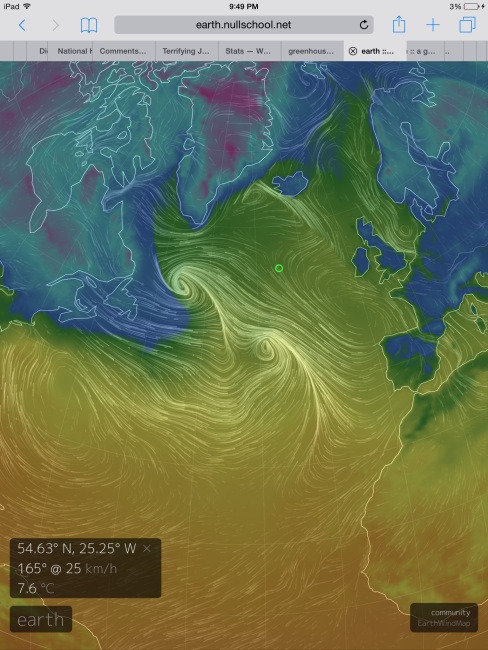
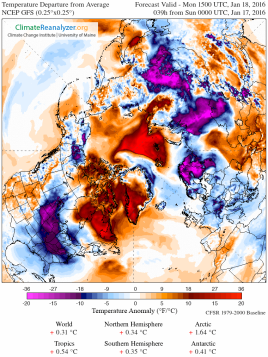
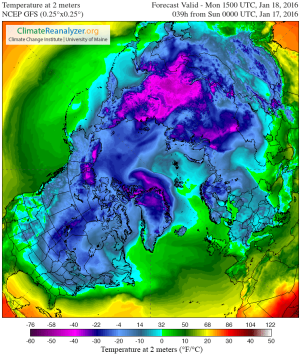
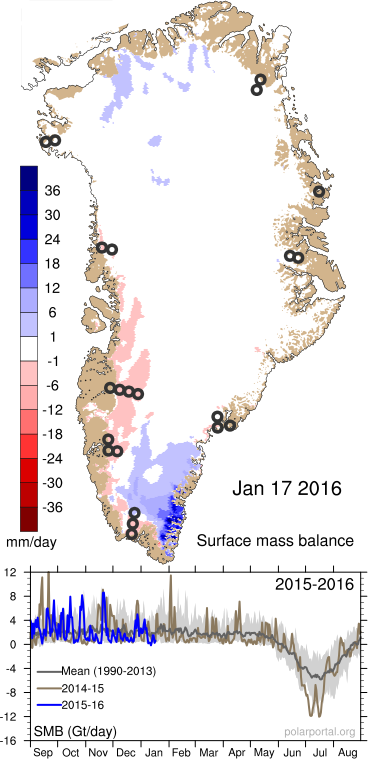
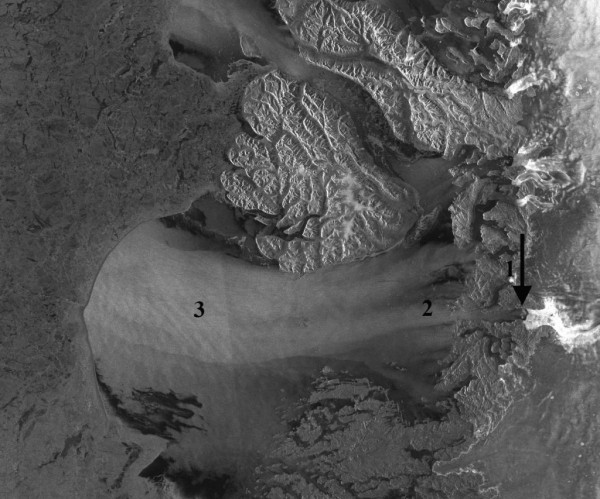
No comments:
Post a Comment
Note: only a member of this blog may post a comment.